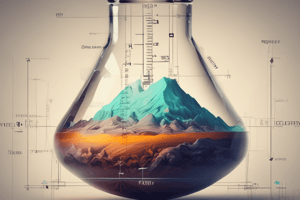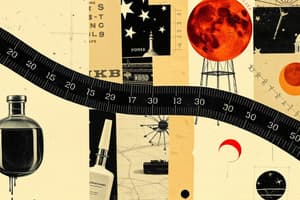Podcast
Questions and Answers
Which of these techniques would be most suitable for drying a heat-sensitive compound?
Which of these techniques would be most suitable for drying a heat-sensitive compound?
- Rotation
- Oven Drying
- Vacuum Drying (correct)
- Air Drying
When using a graduated cylinder to measure liquid volume, which part of the liquid's surface should align with the measurement mark?
When using a graduated cylinder to measure liquid volume, which part of the liquid's surface should align with the measurement mark?
- The top of the meniscus
- The bottom of the meniscus (correct)
- It doesn't matter, as long as the liquid is within the marked range
- The center of the meniscus
What is the primary purpose of grinding a sample in a laboratory setting?
What is the primary purpose of grinding a sample in a laboratory setting?
- To remove impurities from the sample
- To dissolve the sample in a solvent
- To increase the surface area for easier reaction (correct)
- To make the sample easier to weigh
Which of the following is NOT a method for increasing the rate of evaporation?
Which of the following is NOT a method for increasing the rate of evaporation?
What is the main advantage of using a digital weighing scale over a triple beam balance?
What is the main advantage of using a digital weighing scale over a triple beam balance?
Which of these techniques would be most appropriate for removing moisture from a substance that can withstand high temperatures?
Which of these techniques would be most appropriate for removing moisture from a substance that can withstand high temperatures?
Which type of grinder is most suitable for grinding hard materials?
Which type of grinder is most suitable for grinding hard materials?
Which of these techniques separates solids from liquids using gravity?
Which of these techniques separates solids from liquids using gravity?
Flashcards
Triple Beam Balance
Triple Beam Balance
A manual device for measuring mass with precision using sliding beams.
Digital Weighing Scale
Digital Weighing Scale
An electronic tool for mass measurement that provides digital readouts.
Graduated Cylinder
Graduated Cylinder
A primary instrument for accurately measuring liquid volume using marked increments.
Evaporation by Heating
Evaporation by Heating
Signup and view all the flashcards
Vacuum Evaporation
Vacuum Evaporation
Signup and view all the flashcards
Mortar and Pestle
Mortar and Pestle
Signup and view all the flashcards
Oven Drying
Oven Drying
Signup and view all the flashcards
Gravity Filtration
Gravity Filtration
Signup and view all the flashcards
Study Notes
Laboratory Techniques: Week 5-6
- This week's lab focuses on a variety of techniques for measuring mass, volume, and performing evaporation, grinding, drying, and filtration. Each method has specific applications and advantages.
Measuring Mass
-
Triple Beam Balance: A classic method for precise mass measurement. It employs a pan, three sliding beams, and a scale. Calibration is crucial for accuracy but it's a manual process.
-
Digital Weighing Scale: A modern, automated mass measurement tool. It has a digital display and automatic calibration, making it more efficient and accurate for most lab applications.
Measuring Volume
- Graduated Cylinder: A primary tool for measuring liquid volume. Its markings enable precise measurements of a substance's volume. The technique involves aligning the bottom of the meniscus (curve of the liquid surface) with the measurement marks for an accurate reading.
Evaporation Techniques
-
Heating: Applying heat to a solution speeds up the evaporation process.
-
Rotation: Rotating the solution increases the surface area, accelerating evaporation.
-
Vacuum: Reducing pressure above the liquid lowers its boiling point, accelerating evaporation. Vaccuum is ideal for heat-sensitive substances.
Grinding Methods
-
Purpose: Reducing particle size for increased surface area thus making reactions easier.
-
Mortar and Pestle: A manual method for small-scale grinding of herbs, spices, and other materials.
-
Grinder: An electric or manual machine for grinding larger quantities more consistently and efficiently. A grinder offers faster results.
-
Ball Mill: Specializes in grinding hard materials and uses rotating balls to crush samples effectively.
Drying Samples
-
Purpose: Removing moisture for analysis, storage, or further processing.
-
Air Drying: Exposing samples to ambient air for natural evaporation, best for non-heat-sensitive substances.
-
Oven Drying: Using a controlled temperature in an oven to speed up evaporation. Temperatures and time are adjusted based on the specific sample.
-
Vacuum Drying: Lowering the pressure while applying gentle heat is ideal for heat-sensitive samples.
Filtration Techniques
-
Purpose: Separating solids from liquids using a filter medium. Filter mediums are used to retain solids.
-
Gravity Filtration: Using gravity to pull the liquid through a filter. This method is simple and suitable for basic separations.
-
Vacuum Filtration: Using a vacuum to accelerate filtration, crucial for faster separation and removing fine particles.
pH Measurement
-
pH: Measures the acidity or alkalinity of a solution.
-
pH Meter: A modern instrument that measures pH precisely via a probe positioned near the solution, detects the H+ ion concentration.
-
Calibration: Using known pH buffer solutions to ensure the accuracy of pH measurements.
Studying That Suits You
Use AI to generate personalized quizzes and flashcards to suit your learning preferences.




